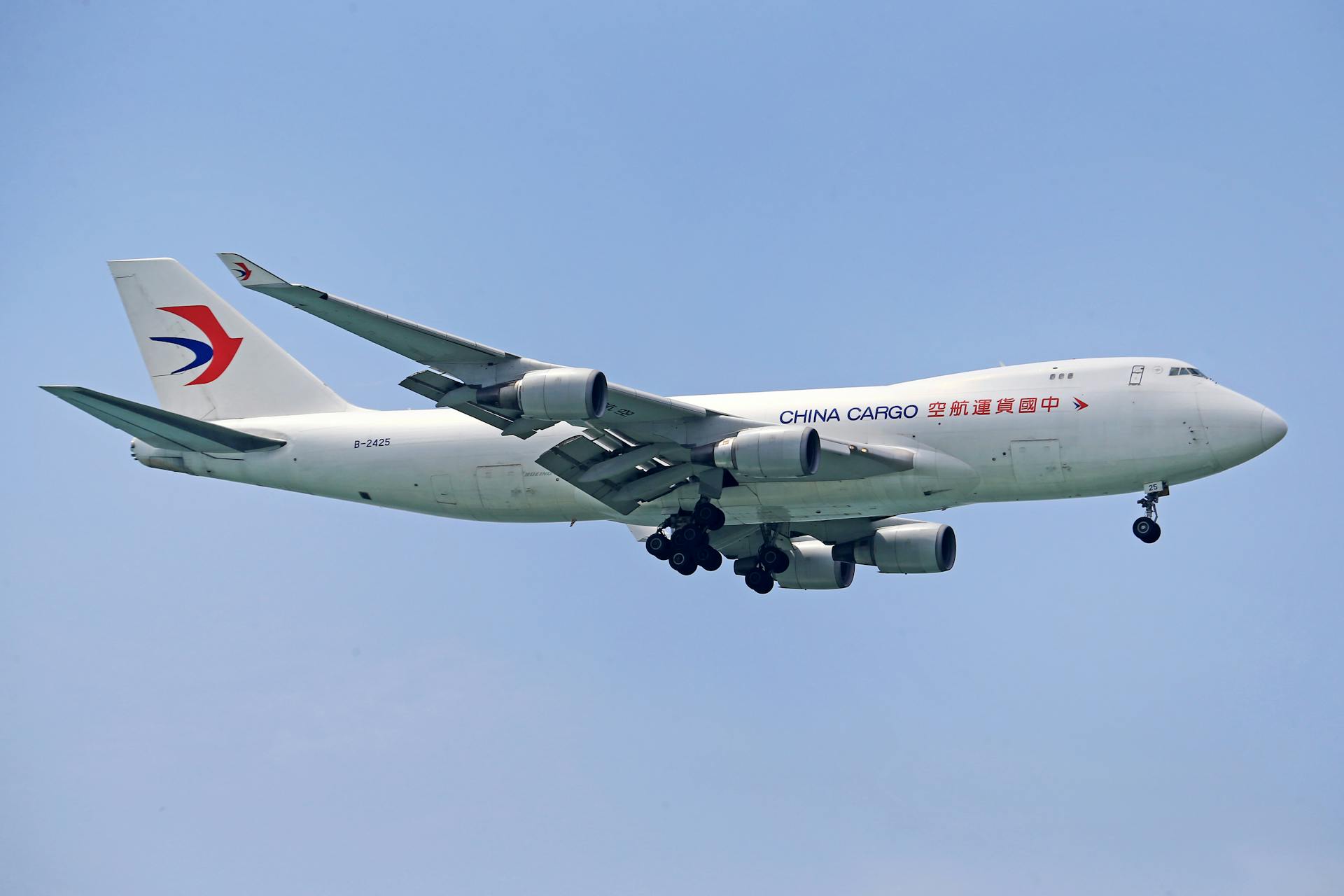
The International Air Transport Association (IATA) Dangerous Goods Regulations Guide is a comprehensive resource for shipping hazardous materials by air. It's essential for anyone involved in the transportation of dangerous goods.
The IATA Dangerous Goods Regulations Guide is updated annually to reflect changes in regulations and industry best practices. This ensures that shippers and carriers stay compliant with international regulations.
The guide provides detailed information on the classification, packaging, and labeling of hazardous materials. It also includes guidelines for handling and transporting dangerous goods by air.
The IATA Dangerous Goods Regulations Guide is widely adopted by airlines, shippers, and regulatory bodies around the world.
What's in the DGR?
The IATA Dangerous Goods Regulations (DGR) is a comprehensive manual that outlines the guidelines for the safe transport of hazardous materials by air. It's based on the International Civil Aviation Organisation (ICAO) guidelines and goes above and beyond to ensure the highest safety standards.
The DGR covers various aspects of shipping dangerous goods, including applicability, limitations, classification, and handling. You'll find information on what's allowed and what's not, as well as specific requirements for each type of hazardous material.
Applicability is a crucial aspect of the DGR, as it outlines the responsibilities of shippers and operators, including training, security, and incident reporting. This ensures that everyone involved in the transportation process is aware of their roles and responsibilities.
The DGR also classifies hazardous materials into nine categories, including explosives, gases, flammable liquids, and radioactive materials. Each category has its own set of requirements and regulations.
Here's a breakdown of the DGR's classification categories:
The DGR also provides detailed information on packing instructions, packaging specifications, and documentation requirements. This ensures that hazardous materials are properly packaged and labeled to prevent accidents during transportation.
Dangerous Goods Regulations
The IATA Dangerous Goods Regulations (DGR) is the industry standard for shipping dangerous goods by air, recognized by airlines worldwide. The DGR is the most complete, up-to-date, and user-friendly reference manual trusted by the industry for over 50 years.
The DGR covers various aspects of shipping dangerous goods by air, including applicability, limitations, classification, packing instructions, packaging specifications, documentation, handling, and radioactive material.

There are nine classes of dangerous goods, outlined in the graphic below:
Some goods are deemed too high-risk to be shipped by air at all, such as rockets and ammunition. However, not all goods within each class are restricted, and the requirements can change from year to year.
Check this out: Dangerous Goods Shipping and Handling Services in Dubai
Pre-Shipment Preparations
Pre-Shipment Preparations are crucial to ensure a smooth and safe transportation of hazardous cargo. You'll need to gather the necessary documentation, which varies depending on the type of product.
A Declaration for Dangerous Goods is a must-have, as it proves the goods comply with IATA's DGR. This document is essential for safe transportation.
A Material Safety Data Sheet (MSDS) is also common, containing vital information about the shipment. This sheet typically includes the ingredients of the goods, hazard assessment, and measures to protect workers.
The MSDS will also outline health effects of exposure and emergency procedures to follow. This information is crucial for handlers and emergency responders.

Here's a breakdown of what you can expect to find in an MSDS:
- The ingredients of the goods.
- Hazard assessment relating to the handling, storage and use.
- Measures need to protect workers/handlers.
- Health effects of exposure (if applicable).
- Any emergency procedures to follow.
By having these documents in order, you'll be well-prepared for the transportation of hazardous cargo.
Special Cases
Lithium batteries are subject to specific regulations, including a ban on their transportation as cargo on passenger aircraft.
The IATA Dangerous Goods Regulations allow for the transportation of small quantities of lithium batteries in carry-on baggage, but only if they are protected from accidental activation.
Certain types of lithium batteries, such as those used in medical devices, are exempt from these regulations.
The regulations also permit the transportation of small quantities of lithium batteries in checked baggage, but only if they are protected from accidental activation.
The maximum net quantity of lithium batteries allowed in carry-on baggage is 8 spare lithium batteries.
The transportation of lithium batteries in cargo is subject to more stringent regulations, including a ban on the transportation of lithium batteries with an installed power source.
If this caught your attention, see: Department of Transportation Regulations for Truck Drivers
Classification and Operations
The classification of dangerous goods is a crucial step in international air transport. The International Civil Aviation Organization (ICAO) or local Civil Aviation Authority Regulations govern the carriage of dangerous goods onboard aircraft.
The Regulations place the responsibility for correct classification of dangerous goods on the shipper. This means you need to ensure you're classifying your goods correctly to avoid any issues during transport.
If you're unsure about the classification of a substance, seek advice from the manufacturer or distributor of the substance. Classification may also be performed by an accredited testing laboratory or advice can be sought from the competent authority.
Here's a quick rundown of the classes of dangerous goods as outlined in the Regulations:
Dangerous Regulation Classes
Dangerous Goods Regulation Classes are outlined in a specific way to ensure safe handling and transportation. The classes are outlined in a graphic below.
Explosives are classified as Class 1, which includes various types of danger such as fireworks and ammunition.
Gases are sub-divided into three categories: Flammable gases (2.1), Non-flammable, non-toxic gases (2.2), and Toxic gases (2.3) which all fall under Class 2.
Flammable liquids are classified as Class 3, which includes substances like gasoline and paint thinner.
Flammable solids, substances liable to spontaneous combustion, and substances which, in contact with water, emit flammable gases are all classified under Class 4.
Oxidising substances and organic peroxides are classified as Class 5, which includes substances like bleach and nail polish remover.
Toxic and infectious substances are classified under Class 6, which includes substances like poison and biohazardous materials.
Radioactive material is classified as Class 7, which includes substances like uranium and plutonium.
Corrosives are classified as Class 8, which includes substances like acid and bleach.
Miscellaneous dangerous substances and articles, including environmentally hazardous substances, are classified as Class 9.
Here's a quick summary of the classes in a table:
Classification
Classification can be a complex and nuanced process, but it's essential to get it right when transporting goods by air.

The International Civil Aviation Organization (ICAO) and local Civil Aviation Authority Regulations govern the carriage of dangerous goods on aircraft.
Many common household items can be considered dangerous goods for air transport, so it's crucial to check if your product falls into this category.
The Regulations place the responsibility for correct classification of dangerous goods on the shipper.
You should seek advice from the manufacturer or distributor of the substance for correct classification, or consult an accredited testing laboratory or the competent authority.
If you have a shipment of electronic equipment containing lithium batteries, it is classified as a dangerous good, but may be exempted from formal declaration.
To determine if your lithium batteries meet the requirements of the "UN Manual of Tests and Criteria, Part III, subsection 38.3", check with the manufacturer or distributor for recent production information.
Material Safety Data Sheets are not required for transport, so you may need to look elsewhere for accurate classification information.
If the safety data sheet (SDS) from the manufacturer doesn't help, further inquire with the manufacturer or distributor or have the product tested by an authorized laboratory.
Here's a quick rundown of the classes of dangerous goods, as outlined in the IATA Dangerous Goods Regulations:
Operations
The IATA Dangerous Goods Regulations is a field manual version of the ICAO Technical Instructions, presenting requirements for shipping dangerous goods by air in a user-friendly format.
It's written and edited by airline dangerous goods experts to help shippers comply and ensure easy acceptance by airlines.
As IATA airlines are stricter than ICAO Technical Instructions, the DGR specifies how to prepare a shipment precisely.
You can find additional information in the DGR to assist with compliance.
If an airline refuses to carry your shipment, talk to them and gather as much information as possible.
Check the State and operator variations of Section 2 in the IATA DGR to ensure you've observed all requirements.
Keep in mind that airlines are free to impose requirements beyond the regulations, as stated in Paragraph 1.2.4.
A full address should indicate a physical location acceptable in the post in that country, and abbreviations are completely acceptable.
Examples of these abbreviations include USA, UAE, AUS, TX, QC, and NSW.
DGR Overview
The IATA Dangerous Goods Regulations (DGR) is the industry standard for shipping dangerous goods by air recognized by airlines worldwide.
Maintaining compliance with the latest regulations is critical for safely shipping dangerous goods by air. The DGR is the most complete, up-to-date and user-friendly reference manual trusted by the industry for over 50 years.
The DGR covers a wide range of topics, including applicability, limitations, classification, packing instructions, packaging specifications, documentation, handling, and radioactive material transport.
Applicability is a crucial aspect of the DGR, covering shipper and operator responsibilities, training, security, and incident reporting.
Limitations are also an essential part of the DGR, outlining forbidden and hidden goods, storage and transport quantities, transport by post, and transport by passengers/crew.
The DGR classifies dangerous goods into several categories, including explosives, gases, flammable, toxic, oxidizing, radioactive, and corrosive materials.
Packing instructions for these materials are carefully outlined in the DGR, specifying the correct packaging and labeling requirements.
The DGR also provides detailed packaging specifications, including inner packaging, UN packaging, construction, and testing requirements.
Documentation is a critical aspect of shipping dangerous goods by air, with the DGR outlining the necessary documentation, including shipper's declarations and air waybills.
Handling and storage of dangerous goods are also carefully outlined in the DGR, covering storage, loading, inspection, information provision, reporting, training, and document retention.
Packing and Shipping
Packing and shipping hazardous goods requires careful attention to detail to ensure the safety of handlers, the plane, and surrounding cargo. The International Air Transport Association's (IATA) Dangerous Goods Regulations (DGR) set strict standards for packaging and labeling.
To meet these standards, you'll need to choose a packaging material that's durable enough to withstand pressure changes. The material of the primary packaging is a crucial consideration, as it must be able to protect the contents from damage.
The DGR also requires that you use the correct label, which can only be obtained from IATA if you're qualified. Most logistics companies will take care of this for you, but if you're shipping hazardous goods yourself, be sure to get the correct label.
The type of packaging you need will depend on the class of your goods. The DGR sets out specific requirements for packaging, including the need for secondary packaging, secure closures, and individual wrapping. You can find a list of companies that supply UN specification packaging in Appendix F of the DGR.
Here are some key packaging requirements to keep in mind:
- Material of the primary packaging
- Need for and material of the secondary packaging
- Security of the closures
- Whether products need individual wrapping
- Cushioning requirements
- Capability of packaging to withstand pressure changes
It's essential to remember that these regulations may mean a less efficient packaging of your goods, so factoring that into your supply chain costs is crucial.
Packaging
Packaging is a crucial aspect of shipping hazardous goods, and it's essential to get it right. The DGR requires more durable packaging than general cargo to protect handlers, planes, and surrounding cargo.
The regulations specify various packaging requirements, including the material of the primary packaging, the need for and material of the secondary packaging, security of closures, and individual wrapping.
You can't just use any cardboard box to meet the requirements; it must meet certain specifications and be capable of specified drop and stacking tests. This includes a 1.2 meter drop test and a 24 hour stacking test for Limited Quantity packaging.
The IATA sets the standards for labelling, and you can only do it if qualified. Most logistics companies will take care of this for you, or you can get the correct label directly from IATA.
Here are some key packaging requirements to consider:
- Material of the primary packaging
- Need for and material of the secondary packaging
- Security of the closures
- Whether products need individual wrapping
- Cushioning requirements
- Capability of packaging to withstand pressure changes
The DGR also specifies that the inners and outers of Limited Quantity packaging must be constructed according to the same criteria as UN specification packaging.
Handling
Handling hazardous cargo safely is paramount, and the DGR covers how to do it correctly. Proper packaging and labelling can make a big difference in ensuring the safety of handlers.
The commodities being shipped may necessitate particular equipment and training, which is why it's essential to follow the DGR's guidelines. As the shipper, you may significantly contribute to the safety of the handlers by properly marking and packing your items.
By providing the correct documentation for your goods, you are going far to ensuring the handlers' safety.
DGR Authority
The DGR Authority is responsible for setting and enforcing regulations for the safe transport of dangerous goods by air. This includes the International Civil Aviation Organization (ICAO) and the International Air Transport Association (IATA).
The ICAO Technical Instructions are the foundation for the DGR, providing the technical requirements for the safe transport of dangerous goods. The instructions are developed by ICAO's Committee on Aviation Environmental Protection.
The DGR Authority has the power to approve or reject applications for the transport of dangerous goods. This includes evaluating the safety of the goods, the packaging, and the shipping procedures.
The DGR Authority also has the authority to investigate accidents or incidents involving the transport of dangerous goods. This helps to identify areas for improvement and to develop new regulations.
The DGR Authority works closely with the aviation industry, including airlines, airports, and cargo handlers, to ensure compliance with the regulations. This includes providing training and guidance on the safe handling and transport of dangerous goods.
Frequently Asked Questions
What is the difference between IATA and ICAO dangerous goods Regulation?
IATA and ICAO have different standards for shipping dangerous goods, with IATA being more stringent due to stricter airline requirements. Understanding the key differences is crucial for safe and compliant transportation.
What is the latest edition of IATA Dangerous Goods Regulations?
The latest edition of IATA Dangerous Goods Regulations is the 66th Edition, which became mandatory on January 1, 2025. This edition incorporates updates from the 2025-26 ICAO Technical Instructions.
Who needs to be IATA certified?
Who needs IATA certification? Logistics operators and anyone handling or transporting dangerous goods in the US, including those who simply label boxes for shipment.
Sources
- https://www.iata.org/en/publications/dgr/
- https://www.thecompliancecenter.com/product-category/publications/iata/
- https://www.wtagroup.com/resources-and-insights/blogs/iatas-dangerous-goods-regulation-dgr-explained
- https://www.iata.org/en/programs/cargo/dgr/faq/
- https://www.icustoms.ai/blogs/iata-dangerous-goods-regulations-dgr/
Featured Images: pexels.com


